Monday, December 29, 2008
Monday Linkage
~~~
Arnold wants to waive CEQA to pass the budget. I like that for transit, not so much for roads.
~~~
Tom Friedman writes gas tax and Oberstar talks about it on NPR.
~~~
A Portland Architect talks about how GM should be the catalyst for a nationwide streetcar revival.
~~~
Four subway lines opened this year. Just not in this country.
Sunday, December 28, 2008
Inertia
90,000 Riders on First Day
Saturday, December 27, 2008
Prop 13 Hangover
H/T YglesiasThis leads to all sorts of idiotic consequences. Back when I lived in California, one of the few ways of raising taxes available to cities and towns was to increase the sales tax by some fraction of a percent. Result? Cities and towns did this, and then tried desperately to induce people to set up car dealerships and other places where people sell big, expensive things. Did it make sense to have so many car dealerships? Who cares! It's revenue!
Likewise, people in California don't always sell their houses when it would normally make sense to do so, because as long as they stay in their existing house, the assessment will not rise much and their taxes will stay low, whereas if they buy a new house, it will be assessed at its purchase price, and their taxes will go up.
"Free markets", indeed.
Opening a Line Always Popular
Post Christmas Day Linkage
~~~
The Tram that serves OHSU in Portland did an amazing job keeping people working there linked to the city during the snow storm.
The tram, which extends from a streetcar stop in South Waterfront up to OHSU, helped the hospital keep running through the worst of the snow. With buses unable to make the trip up to Marquam Hill, OHSU kept the tram running until midnight so that patients and staff could get up to the hospital and back down the hill again.~~~
Light Rail is now open in Phoenix!
~~~
California HSR could get $20B from the stimulus. That would be a great contribution to the future of California, just like the aqueduct was many years previous. Personally, I'd like to see us hire Dutch engineers for New Orleans and California's Levee problems. I know its off topic, but its something that needs serious attention too and will benefit for many years to come.
~~~
More on the big push from Congressman Oberstar.
Oberstar said, "We're going to rewrite the whole book on this thing." The stimulus package is the prologue to a broader effort to show that mass transit is not just a good idea; it's a vehicle America can ride into the future.This makes me think there needs to be a name for our movement. Something simple. The Big Push? Any suggestions?
~~~
This seems a bit much to me. $668 million for a crossover track between Walnut Creek and Concord on BART?? Isn't there a better use for that money? Anyone know anything about this?
~~~
And finally, Dan shows us how to man up in the snow.
Thursday, December 25, 2008
Good for Chu
"Somehow we have to figure out how to boost the price of gasoline to the levels in Europe," Steven Chu, the director of the Lawrence Berkeley National Laboratory, told the Wall Street Journal in September.From the Wall Street Journal Article:
In a sign of one major internal difference, Mr. Chu has called for gradually ramping up gasoline taxes over 15 years to coax consumers into buying more-efficient cars and living in neighborhoods closer to work.At least someone in the administration gets it. Apparently Obama does not, at least publicly.
But Mr. Obama has dismissed the idea of boosting the federal gasoline tax, a move energy experts say could be the single most effective step to promote alternative energies and temper demand. Mr. Obama said Sunday that a heightened gas tax would be a "mistake" because it would put "additional burdens on American families right now."
Replay 10.16.07: Vienna's Ringstrasse

What is the history of this tram ring that allows the circulation of this signature street? Initially the ring was the city fortifications. However Franz Joseph, the King of the Austrio-Hungarian Empire decided that it wasn’t needed anymore and wanted to create a signature street. And create a meaningful place he did. The street is very wide and accommodates automobiles, streetcars, as well as a wide tree lined pedestrian and bike space.
The most interesting piece related to transit is not really the loop itself, although its an important part of both Vienna and Budapest transport, but rather the multimodal connections that are made at certain nodes along the Ringstrasse. At one node, there are four tram stops on the surface, a tram turnaround just beneath the surface and a connection to the M2 Metro which follows its own ring around half of the downtown. In the photos below you can kind of see how this works.


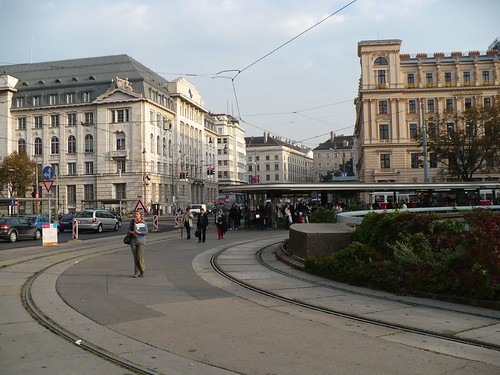
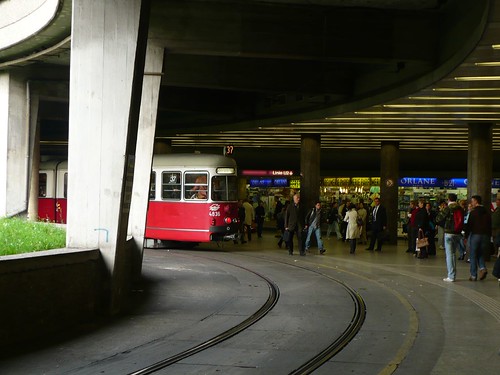
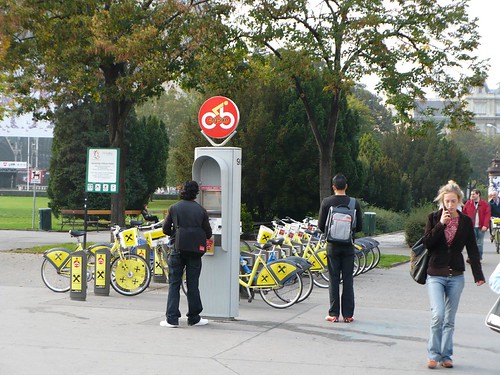
In another node, there are loops for trams, buses and the Metro connected by tunnels which allow citizens to not cross the Ringstrasse on the surface. Underneath the surface its like a mini-mall with eateries and the infamous Tabak shops where you can buy cigarettes and your metro pass.
So why do these systems work? Well first off they are the circulators for all modal connections with in the central city. Their operation is dependent on the interface of faster Metro lines and slower tram and bus connections (the photo below is a tram and bus stop). In Vienna specifically the buses sometimes are even using the tram right of way and stops of the trams. They also all connect to the intercity trains on the edges of town allowing anyone living in town to get around effortlessly without a car.
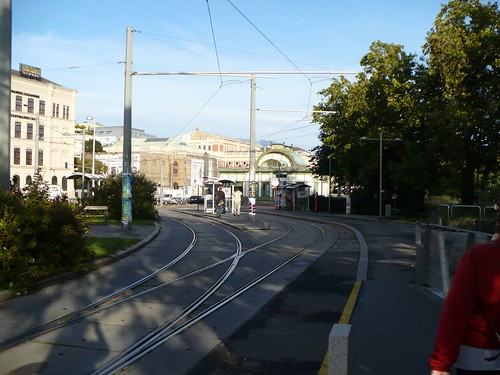
This means that its incredible affordable to live in the old parts of Vienna. I was told that inside the ring is expensive, but just outside of the ring you can get a nice flat for $600 per month. I will warn folks that there are lots of good restaurants there so food could get expensive.
And if you're worried about the environment, there are people there to remind you.
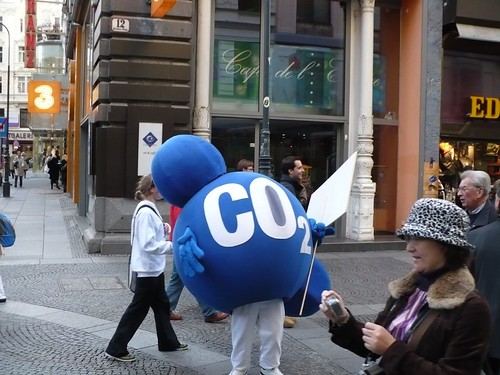
Tuesday, December 23, 2008
Anti-Rail Activist Out of Office
Transit Not Roads
Monday, December 22, 2008
Design Matters
Transit Can't Do All the Work
Signs of the Apocolypse
"I'm sick of people whining about a lousy 50-cent-a-gallon tax on gasoline! I think its time has come, and I call on all non-wussy politicians to stand with me, because our country needs us."Amen.
Final Administration Push on HSR
H/T NJH
Sunday, December 21, 2008
Dumb Criminals
We're Waiting...
By local folks I hope he means local planning officials and residents, not people like Tom Delay.At the end of his brief remarks, LaHood made a comment sure to endear him to every mayor and county leader who's complained about unfunded mandates and dictates from D.C.
"It's the local folks who know best their transportation needs," he said.
Friday, December 19, 2008
Friday Night Linkfest: Stimulus & Transit
~~~
Congressman Oberstar has our back. He wants to spend more on transit, and if the highway junkies don't like it, tough.
~~~
Ahem. Advocates are not split Boston Globe. We want transit, walking, and biking projects. There is no dichotomy of we have to build roads because they will create jobs and the other projects won't. That is complete and utter bs.
~~~
Tunnel lovers just won't give up (I wish there was a tunnel). Shouldn't this project have been built years ago? Get it started already!
~~~
The Cinci NAACP is opposing a streetcar project complaining about potholes in neighborhoods. Seems to me like they should be opposing all those suburban road projects. This is exactly how the Madison streetcar died, except that time, it was police coverage. The trade off shouldn't be transit or streets or police.
Action! How Is Your State Going to Spend?
A Nice Word
We have a task before us to rebuild America. As a nation, we need to continue to be the world leader in infrastructure development, Amtrak, mass transit, light rail, air travel, and our roads and bridges all play a vital role in our economy and our well-being as a nation.What no HSR, Walking, Biking and (insert forgotten mode here)?
Thursday, December 18, 2008
Before You Walk Out the Door
Baltimore City Red Line coordinator Danyell Diggs also blamed federal officials for the loss of funds."This is just one final anti-transit action by the Bush administration on its way out the door," said Diggs in an e-mail.
"We are looking forward to January 20 and a president who values transit as a means of strengthening communities." Milkulski spokesman Cassie Harvey said FTA officials decided to redistribute the funds outside Maryland after Congress failed to re-authorize New Starts, a federal program that funds mass transit projects nationwide.
A Strong Market
Wednesday, December 17, 2008
More LaHood Background Information
Yonah covers in detail (as usual) a few of his past transportation details. He covers some Amtrak in LaHood's home town, making a rail ROW into a trail instead of preserving it for future service, and funding for a local road project.
Modemocrat at DailyKos has a bit of background on LaHood from a bit of a political angle for the pick. He discusses why this might be a savvy political move and how his ability to work with republicans could possibly be a boon for big infrastructure projects due to his knowledge of the appropriations process.
In the same vein at the Prospect, Dana Goldstien makes the argument that this appointment could possibly neutralize transit as an urban snob issue.
In my opinion, his appropriations knowledge and closeness to congress might be a strike against him as he is too familiar with the process and could be slow to change it (we know it needs to get deep sixed), or understand the changes that need to be made in say the New Starts program. There are a lot of little details that need changing. Will he know as Robert notes, "...the FRA's weight rules? Does he support 80/20 funding for mass transit?" Things of that nature.
Austin Bike Blog notes that LaHood is a member of the congressional bike caucus. It's quite the long list but he was supportive of Congressman Blumenaur's commuter benefits package. Looking through some back news, he was one of two Republicans that voted in committee to keep funding for bike improvements in the 2003 transportation appropriations bill. It was initially ripped out by Rep. Istook of OK. LaHood even testified on the house floor for the bike and ped enhancements.
He's not without his bad connections as well. He tried along with Rep Culbertson of Houston (who was the target of one of my first posts ever) to keep Rep Chris Bell from filing ethics complaints against Tom Delay. He also praised a member of his constituency on the floor in 1997 who was appointed VP to the Petroleum Marketers Association of America. Though he was in the Pig Book for earmarking green building tech, his environmental record is pretty shoddy.
He also supported (H/T AK) an Interstate connection to Chicago but later pulled back on that, working to fund local freeways instead.
The largest employer in his district is Caterpillar, a heavy machinery company that makes earthmovers and backhoes. He's also earmarked funds for CAT. Yes CAT machinery is used to build roads. Perhaps they should start into the rail machinery now.
A few of the related bills good or bad that he has co-sponsored recently (with a lot of other people):
Commuter Act of 2008 - To amend the Internal Revenue Code of 1986 to allow employers a refundable credit against income tax for 50 percent of the employer's cost of providing tax-free transit passes to employees.
Recognizing Importance of Bicycling as Transportation and Recreation Res
Bicycle Fringe Benefit - To amend the Internal Revenue Code of 1986 to extend the transportation fringe benefit to bicycle commuters.
As for regular transit, after his Amtrak talk and possible anti-HSR stance, there is nothing about buses or light rail anywhere, at least that I could find. I'll keep looking for more information tomorrow.
LaHood-Winked?
I'll be deep in the Googles later tonight looking for dirt, good or bad. I'll post what I find.Newly elected U.S. Senator Barack Obama (D) noted, "Every year they make the same proposal and some of it is just ideological.... It strikes me that we should make a greater investment in upgrading our rail system rather than eliminating the subsidies that already exist. "If you look at the amount of subsidies that we provide the highways relative to the subsidies that we provide rail transportation, it pales in comparison." Obama echoed a comment many Amtrak supporters have made for years saying, "We're the only developing country in the world that doesn't make a significant commitment to our rail transportation system."
U.S. Rep. Ray LaHood, R-Peoria, also rejected the Bush rail plan. He said he favors maintaining the current Amtrak system but didn't rule out small changes to make the railroad more efficient. "We've got a good Amtrak system in illinois and I don't think we want to destroy it by talking about privatization," LaHood said in a telephone interview with the Peoria Journal Star. "The subsidies need to continue. These subsidies are the lifeblood of Amtrak continuing the kind of service they have to the college towns and the small communities in illinois and around the country. I don't see us really tinkering with that."
Tuesday, December 16, 2008
Lancaster PA, VMT Champ
I hadn't heard much about Lancaster before the Streetcar issues that have been going on there with the FTA but the little interaction I've had is with Google Earth. The first thing you notice (if you're a nerd like me) is that the major freeways stay relatively far away from the center of town, there is a grided street pattern throughout the city, making walking, biking and transit more likely, and the Amtrak station actually serves fairly frequent trains to Philadelphia.
 Eisenhower was freaked out by the idea of freeways going through our cities. It was pushed through anyways as the people who took over the Interstate program showed no mercy in cities. Perhaps this is a case study of what happens when we keep them out.
Eisenhower was freaked out by the idea of freeways going through our cities. It was pushed through anyways as the people who took over the Interstate program showed no mercy in cities. Perhaps this is a case study of what happens when we keep them out.
Remember the Alamo
The shocker last night wasn't so much that a local toll-road official will take over as chairman of VIA Metropolitan Transit.This might be the first shot in a long Texas war that would attempt to combine these recently created mobility authorities with local transit agencies. Not something that is unfamiliar so close to the Alamo. My fear is a region wide transportation authority focused on toll roads will give suburban jurisdictions too much clout over all transportation and leave the more urban areas hanging out to dry. Specifically, Austin's outside pols have been trying to take away Capital Metro's sales tax for as long as anyone can remember. We'll have to watch and see what happens, but color me skeptical.It had more to do with a revelation that behind-the-scene talks have drifted toward the possibility of merging the toll and bus agencies into a super agency. The Alamo Regional Mobility Authority, which is banking on toll-road plans but can pretty much do any type of transportation project, recently outlined an idea to create an overarching Multi-Modal Transportation Finance System.
With it, VIA and the RMA would combine to maximize financing capacity while allowing each agency to operate independently, says the RMA document, which was prepared for a city-county transportation task force.
Planning for Kids
Monday, December 15, 2008
Marsha Marsha Marsha
"Why do the buses get the privilege?" asks Mary Rheaume, who lives a few blocks from Cedar Avenue and is unimpressed with the new signal. "Why can't they take the loop like everybody else?"
TAR Gets a Bit Feathered
Who knew he was going to come back on that earlier decision? Well perhaps everyone who's ever encountered one of his writings. He did state that he felt buses were a better option, such as he usually does as long as it doesn't have its own ROW. The quote of the story:A new study by a libertarian think tank claims the projected economic benefits of a proposed Milwaukee-to-Kenosha commuter rail line have been inflated and questions its ridership estimates.
But a business leader noted that the author of the study, Los Angeles-based transit consultant Tom Rubin, took a far more positive view of the $200 million project in June, when pro-transit business leaders were pushing the Southeastern Wisconsin Regional Transit Authority to hire him as the authority's consultant. And a regional planner said the commuter rail projections were sound.
H/T Political EnvironmentPete Beitzel, a vice president of the Metropolitan Milwaukee Association of Commerce, suggested Rubin's opinions depended on who was paying him. "The think tank guys got real mad at him when he said it (the KRM line) was a good idea," Beitzel said. "Apparently, they hired him to change his mind."
Mental Block Hop
Sunday, December 14, 2008
Two Percenters
Spending on upkeep of transit systems in older centralized cities such as New York, Washington and Chicago also seems logical. But with few exceptions -- the heavily traveled corridor between downtown Houston and the Texas Medical Center, for instance -- ridership on most new rail systems outside the traditional cities has remained paltry, accounting for barely 1 or 2 percent of all commuters.This 2% bullshit needs to stop. Stop comparing a single transit corridor or a poorly funded transit network to all roads in a region. Let's compare a single road project to the whole region next time. The next interchange, i'm going to be all about comparing the number of trips. Heck the big dig only takes 2% of trips. Stop it. Wendell Cox or Robert Poole say all the time we should spend money depending on existing trip percentages. That doesn't do us any good and only enforces the current shares. We should be spending more money on livability infrastructure.
Another interesting thing about Kotkin's screed is that he praises Houston's light rail line, which he and his followers bashed in the past. So what's it going to be Joel? There's a whole lot more wrong with his ideas on the stimulus, but I'll leave that to others.
Absorbing Growth
Transportation officials say a new study shows a surprising trend: As New York City's population and job base grew during the recent boom, traffic didn't.Instead, a report due for release Monday finds the transit system absorbed the influx of residents and commuters between 2003 and 2007.
City deputy transportation commissioner Bruce Schaller says that's a first for at least the years since World War II. Schaller wrote the study. He says improvements to the subway, bus and commuter rail network helped it handle the demand from 130,000 new residents and 200,000 more jobs.
Name Him Acela?
Streetcar Weekend
Lexington
Hartford
Waco
Patrick Condon in the Globe and Mail
Illegal in Tulsa
"What we got out of that (the citywide workshops) is a pretty different view of Tulsa than the forecast we've seen for Tulsa," Fregonese said. "In fact, what was put on the maps is in many cases illegal; in fact, most of it is illegal, most of it is not permitted, let alone not planned for and not anticipated and not desired."As Ryan mentions, in order to optimize these changes people want, we need to make the institutional changes to the zoning codes and planning that backs up our infrastructure spending.
Overlay the Past
If you've seen one of these overlays somewhere, shoot a link in the comments and I'll append them to this post.
Stadler Doesn't Look So Bad Now
Really? Waco?
Friday, December 12, 2008
Friday Night Linkfest: Streetcars & Secretaries
~~~
Sources say former Dallas Mayor Ron Kirk is one of two supposed finalists for the Transportation Secretary job along with Steve Heminger from the Bay Area MTC. The article says nothing about what Kirk has done on transportation issues and only that he was an early supporter and friend to Obama. Who wants cronies! Anyone have any more info on this person? I will note that he was in Office when light rail started running in Dallas.
Heminger on the other hand took any mention of electric transit out of the report for the recent Revenue Policy Study. It was put back, but he's also famous around the Bay Area by progressive transport nerds for his stance on promoting HOT lanes as the only way short term to cut congestion and pollution.
~~~
Rep Peter Defazio is certain that an Obama administration will fund the East Side Streetcar project in Portland. This could bode well for other projects.
~~~
This is heartening, but I'd really like to hear more about it than this.
~~~While details have not been finalized, the bill is expected to include tens of billions of dollars for highway, mass transit, airport, and intercity passenger and freight rail improvements.
Bush's transportation philosophy "seemed to be, 'This is what the federal government should be responsible for and nothing else.' And the 'nothing else' category was public transportation," said William Millar, executive director of the American Public Transportation Association, whose members include transit agencies.
Obama, on the other hand, has described himself as a strong advocate of mass transit.
While Bush proposed what some lawmakers described as "starvation budgets" for Amtrak, Obama has pledged support for the passenger rail carrier and for developing a national network of high-speed passenger trains.
The BRT - Light Rail saga continues on the Purple Line. A bad frame was used at a recent meeting. David Alpert fixes it.
It's too bad Gonzalez is thinking about the project using this analogy. A Lamborghini and a VW both get you from point A to point B, and except in a drag race, in pretty much the same amount of time. Not so with the bus versus light rail option. The light rail is faster, carries more people, and would use its own right of way for big chunks of the route, avoiding a lot of traffic. A better analogy would be, if the County builds a new school, should they buy big yellow buses or little golf carts to transport kids to school? Even if they're much slower and hold fewer students, they cost less, so why not?
Thursday, December 11, 2008
Find Out What You're Asking For
For San Francisco, here's the link. Definitely needed things including a new control room and midlife overhauls for buses and the Bredas. I wonder if they have pong on their current control room computers.
And the city that sees this as an opportunity to do big things, Salt Lake City. Asking $403 million for five different light rail projects.
Another quirky thing, Austin asks for $80 million to update the current commuter rail line ($220 in rail asks). Does this mean electrification? Double tracking? Is that possible? What does urban rail vehicle purchases mean. Soooo confused!
If you find something interesting, let us know in the comments.
Forgetting Something?

Veins & Capillaries
Then check out all these flights up the Northeast Corridor from Atlanta.
More Silver Line
Update 12.11.08: The Boston Globe is reporting that the Silver Line is getting down-rated to a Medium Low in the next New Starts report coming in February. This means that it would not be able to get funding because a medium rating is required. It's primarily due to the debt load of over $8 billion that the MBTA is carrying. Bill also mentions the atrocious ridership of the existing Waterfront Silver Line segment, half of which is going to be cut. It costs $9.16 per boarding in subsidy versus the Washington Street Section which is 48 cents. Amazing.
Bill reports that the folks at Boston Common don't like the Silver Lie BRT tunnel. Why would you tear up an existing usable tunnel that held rail vehicles for a poorly thought out bus tunnel? It just doesn't make any sense. But alas I'm sure it will continue to go through its approvals...
Wednesday, December 10, 2008
Transit Energy Efficiency & Lifecycle Costs
At Rail~Volution I saw a presentation by Tina Hodges at the FTA that had some cool charts and comparisons of modes. The one I've seen before is the increase in VMT versus what CAFE standards will do. Now we've seen that there is a bit of a drop recently due to the economy but with gas prices as they are and no change in habits, I still believe this will happen.

Then here is the difference between current occupancies vs. all of the vehicles full and over the lifecycle of the vehicle in the second chart. These are based on a UC Berkeley study by Mikhail Chester that considered vehicle construction, guidway construction etc. The list of items lifecycled are at the link. Apparently buses off peak are the worst and peak are the best, even better than rail lines. Yet rail lasts longer and attracts more passengers overall so on average is better. I didn't really have time to read the 332 page tome, but if you're interested go for it.


But the most interesting in the presentation to me was the difference between the Heavy Rail modes. BART is the most efficient while Cleveland is almost as bad as a single occupancy vehicle. The relative inefficiency of the EL was surprising to me as well.
 Thought this would be of interest to folks. I have to say again that its necessary to not just measure the lifecycle and modes but rather the land uses and transportation, but its interesting to learn that this work is being done.
Thought this would be of interest to folks. I have to say again that its necessary to not just measure the lifecycle and modes but rather the land uses and transportation, but its interesting to learn that this work is being done.
Transit Links
~~~
The first run of the Savannah Streetcar.
~~~
If the auto bailout passes, it looks like there will be help for transit agencies involved in those leaseback deals. While these deals might not have been a great idea, it just shows how underfunded our transit agencies are compared to the road complex.
~~~
Some leaders in Milwaukie, Oregon are a bit skeptical about the MAX line that is proposed to come to town.
Tuesday, December 9, 2008
Rediculous Costs + Dumb Ideas
Buildings of Yore
Speaking of Louisville, its an interesting case. It's not a city I hear much about but Broken Sidewalk has brought it to life. The only other contact I've come in with Louisville was when I was looking over thier long range transit plan a few months ago. They have a robust plan, but thats all it is. A plan on a shelf. In fact, they must have taken out the maps that show the transit corridors because I can't find them now. "Waiting until funding is available." Here is another place that needs a bit of a push. If offered funding for a complete system through a better federal match, perhaps that would get the wheels rolling. Some places need a bigger push than others.

